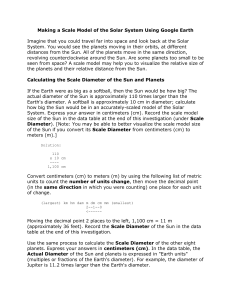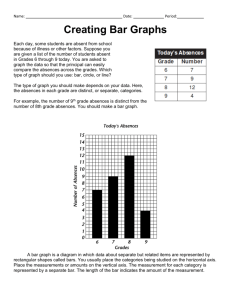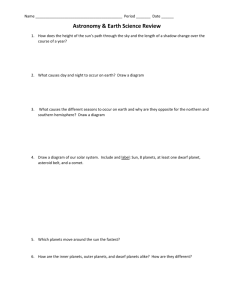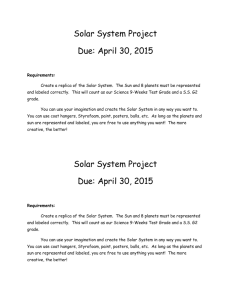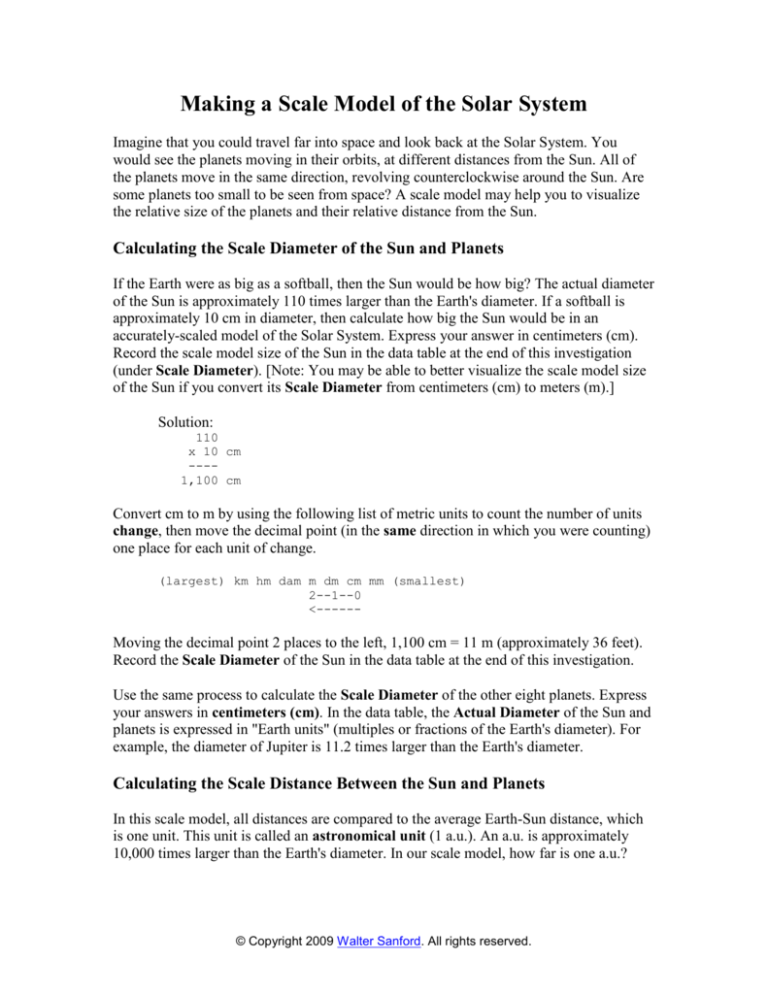
Making a Scale Model of the Solar System
Imagine that you could travel far into space and look back at the Solar System. You
would see the planets moving in their orbits, at different distances from the Sun. All of
the planets move in the same direction, revolving counterclockwise around the Sun. Are
some planets too small to be seen from space? A scale model may help you to visualize
the relative size of the planets and their relative distance from the Sun.
Calculating the Scale Diameter of the Sun and Planets
If the Earth were as big as a softball, then the Sun would be how big? The actual diameter
of the Sun is approximately 110 times larger than the Earth's diameter. If a softball is
approximately 10 cm in diameter, then calculate how big the Sun would be in an
accurately-scaled model of the Solar System. Express your answer in centimeters (cm).
Record the scale model size of the Sun in the data table at the end of this investigation
(under Scale Diameter). [Note: You may be able to better visualize the scale model size
of the Sun if you convert its Scale Diameter from centimeters (cm) to meters (m).]
Solution:
110
x 10 cm
---1,100 cm
Convert cm to m by using the following list of metric units to count the number of units
change, then move the decimal point (in the same direction in which you were counting)
one place for each unit of change.
(largest) km hm dam m dm cm mm (smallest)
2--1--0
<------
Moving the decimal point 2 places to the left, 1,100 cm = 11 m (approximately 36 feet).
Record the Scale Diameter of the Sun in the data table at the end of this investigation.
Use the same process to calculate the Scale Diameter of the other eight planets. Express
your answers in centimeters (cm). In the data table, the Actual Diameter of the Sun and
planets is expressed in "Earth units" (multiples or fractions of the Earth's diameter). For
example, the diameter of Jupiter is 11.2 times larger than the Earth's diameter.
Calculating the Scale Distance Between the Sun and Planets
In this scale model, all distances are compared to the average Earth-Sun distance, which
is one unit. This unit is called an astronomical unit (1 a.u.). An a.u. is approximately
10,000 times larger than the Earth's diameter. In our scale model, how far is one a.u.?
© Copyright 2009 Walter Sanford. All rights reserved.
Solution:
10,000
x
10 cm
------100,000 cm
Convert cm to km by using the following list of metric units to count the number of units
change, then move the decimal point (in the same direction in which you were counting)
one place for each unit of change.
(largest) km hm dam m dm cm mm (smallest)
5--4--3--2--1--0
<---------------
Moving the decimal point 5 places to the left, 100,000 cm = 1 km. Record the scale
model size of an a.u. in the data table at the end of this investigation (under Scale
Distance to Earth).
In the data table, the Actual Distance between the Sun and planets is expressed in a.u.'s
(multiples or fractions of the average Earth-Sun distance). Use the scale model size of an
a.u. to calculate the Scale Distance between the Sun and the other eight planets. Convert
your answers from centimeters (cm) to kilometers (km). Record your answers in the
following data table.
Scale: 1 a.u. = _____
Actual
Scale
Actual
Scale
Scale
Diameter Diameter Distance Distance Distance
(e.u.)
(cm)
(a.u.)
(cm)
(km)
110
----
Sun
and
Planets
Sun
Mercury
0.4
0.4
Venus
1.0
0.7
Earth
1.0
Mars
0.5
1.5
Asteroids
<0.07
2.8
Jupiter
11.2
5.2
Saturn
9.5
9.5
Uranus
4.0
19.2
Neptune
3.9
30.1
Pluto
0.2?
39.5
Nearest Star
100
270,000
10
1.0
© Copyright 2009 Walter Sanford. All rights reserved.
For Further Thought
1. An accurately-scaled model of the Solar System should use the same scale for
size and distance. Does this model use one or two scales for size and distance?
2. The distance between the Earth and the Moon is approximately 1/500 (.002) of an
a.u. Use the scale model size of an a.u. (1 a.u. = 1 km) to calculate the Scale
Distance to the Moon. Express your answer in meters (m).
3. At a distance of 4.4 light-years away, Proxima Centauri is the star nearest to the
Sun. If the Scale Distance to the nearest star is 270,000 km, and the actual
circumference of the Earth is approximately 40,000 km, then how many times
would you have to go around the Earth to "travel to" Proxima Centauri?
Activity Extension
1. Use a map of Fairfax County, VA to plot the Scale Distance between the Sun and
the nine planets in our Solar System. Arbitrarily plot a point on the map to show
the Sun's location (for example, the location of your school). Measuring from the
Sun's location on the map, use the Scale Distance (in the Solar System model)
and the scale of the map to plot the location of the nine planets. You may want to
use washable marking pens to mark the location of the Sun and planets on a
laminated map. Alternately, use push-pins to "flag" the location of the Sun and
planets on the map.
Remember that this model represents one radius of the Solar System--the
diameter of our Solar System is actually twice as big as this model!
2. Construct a physical model of the Solar System. Get started by visiting the
Exploratorium Build a Solar System Web site. Be sure to select a body diameter
for the Sun which results in a model that is practical to construct!
© Copyright 2009 Walter Sanford. All rights reserved.


